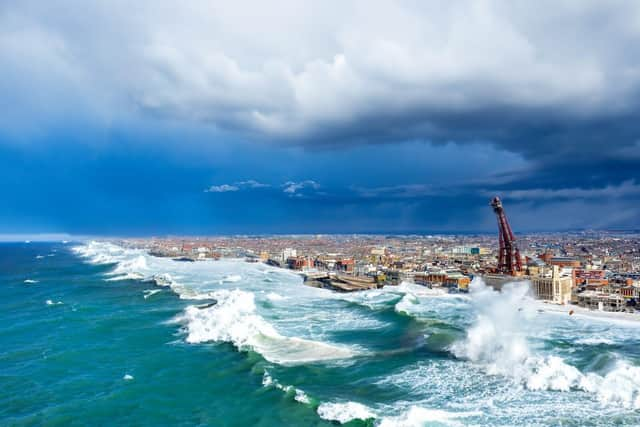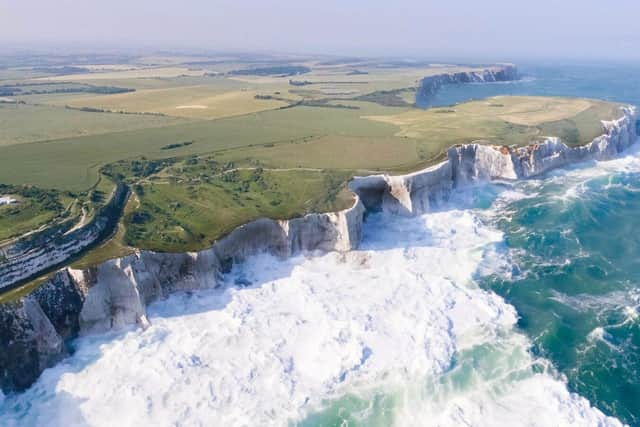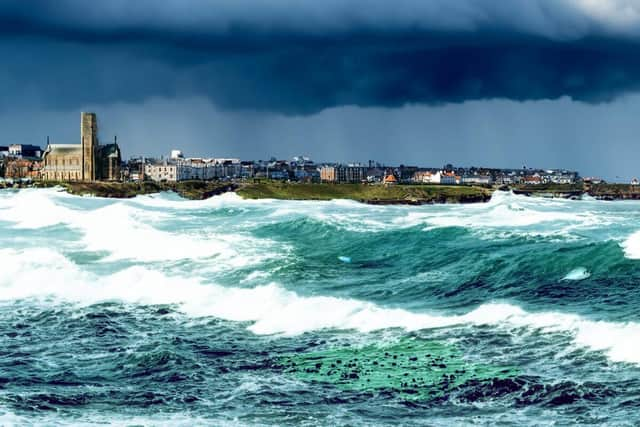AI's chilling prediction: iconic beach destinations vanish by 2050 as oceans deteriorate
and live on Freeview channel 276
Jordan Kelly, Brand manager at Oceans, says: “Ocean warming might sound distant to many of us, but the effects this can have on locations much closer to home can be detrimental. No one wants to think of their favourite holiday destinations or local coastlines declining, but that is the reality for our future.
“Whether you’re simply swapping to sustainable products or you’ve taken part in the Great British Beach Clean this year, every small effort towards saving our oceans guides us away from these deadly scenes.”
Advertisement
Hide AdAdvertisement
Hide AdWith the use of AI imaging, Oceans, a provider of plastic-free toilet paper, predicts what common coastline locations around the UK will look like as soon as 2050 if we don’t start caring for our oceans soon.


Southeast Coastline
The Southeast coastline is another area of the UK likely to be impacted by the mistreatment of our oceans by 2050. Unless efforts towards carbon dioxide reduction and climate change are drastically implemented, we can expect most of the southeast coastline to be underwater by 2050.
Not only will we see our coastlines vanishing, but we can also expect some homes and businesses to suffer from the encroaching water level. By 2050, some people might need to relocate further inland to escape the water level rising, as many coastal properties in the South are likely to flood or fall below sea level in the near future.
Jordan says: “This brings the damaging effects of climate change much closer to home for many. Rising sea levels are a threat to many coastal homeowners, and properties could be gone in as little as the next 27 years. This is why acting now and protecting our oceans is so crucial.”


Advertisement
Hide AdAdvertisement
Hide AdStorm surges and high tides will also pose a problem to nearby farmland. Not only will some communities be out of home, but our farming industry will suffer from land and resource issues as bad weather continually causes these locations to flood.
North Sea
As AI predicts, the North Sea is expected to see some changes in the next 27 years alone due to climate change. From Tynemouth to Tønsberg, coastal towns are expected to be under threat from the rising levels of the North Sea. As sea levels rise, flooding and erosion will become a reality, with landmarks such as Tynemouth Priory and Castle and Oseberg Mound likely to be damaged or even lost under the sea level.
Another drastic change we can expect is the shift from our blue waters to a murky brown. No more looking out to sea and watching the sunset over the blue. Instead, we will have dark, polluted waters to look forward to.


The acidity of the water will change, too – making it a more hostile environment for marine life. The acidity will make it difficult for shellfish, who rely heavily on calcium carbonate for their shells, to live in these areas. The depleting oxygen levels will also likely lead to “dead zones” in which no marine life will live.
Advertisement
Hide AdAdvertisement
Hide AdThe North Sea has a rich fishing history, but with the pollution and overfishing of the water, we can expect herring to become rare to find. We can also expect rivalry between fishing ports and an economic decline due to the lack of fishing ability in the empty areas.
Blackpool
Blackpool is the iconic seaside holiday town, but by 2050, we might not be able to enjoy it to the extent that we do now. The rising sea levels threaten to take the iconic pier and the beach into its waves before we hit half a century – meaning that you’ll more than likely see a crab rather than a claw-grab machine.
For many, seaside visits during the summer won’t be the first choice – with the murky waters and flooding likely to put a dampener on the holiday. And the once spacious beaches will lose their depth, meaning that Blackpool will start to feel much more cramped.
There might be a strain on infrastructure, too, as Blackpool council will need to put more resources and time into ensuring the town is protected from flooding. Even with rain, we might expect Blackpool to flood easily due to the rising sea levels – putting immense stress on the roads and drainage systems. This means that there will need to be constant upgrades and maintenance to help reduce the impact of flooding.
Advertisement
Hide AdAdvertisement
Hide AdThe once-vibrant beachfront will become a thing of the past as coastal erosion comes to ruin the fun. Landmarks such as the Blackpool Tower will be at risk, and we can expect the town’s bustling nature to die down as more people look to move inland.
Irish Sea
Like the North Sea, we can expect the same decline in our waters on the other side of the country. The Irish Sea can face many of the same consequences as the North Sea by 2050.
With rising sea levels, storms will pose a much greater threat to flooding. Everywhere, from Blackpool to Belfast and the Isle of Man, will likely see heavy flooding. This will put extra strain on resources and councils to ensure areas are prepared for the effects of bad weather.
Again, we can also see marine life suffering in this environment. There are currently up to 10,000 Grey seals in the Irish Sea, but we can expect this number to drop by 2050. This comes as a knock-on effect from pollution, overfishing, and habitat destruction. And with the Arctic expected to have ice-free summers by 2050, there won’t be stable habitats for these creatures across the globe.
White Cliffs of Dover
Advertisement
Hide AdAdvertisement
Hide AdThe White Cliffs of Dover are an iconic landmark which has inspired many poets, writers, and artists for centuries. Not only are they a source of beauty for the UK, but they also house nature, including butterflies and birds. This is a carefully conserved location for wildlife, which could be under threat from the rising sea levels.
We are likely to see the cliffs become unstable, with large chunks of chalk falling off into the sea. The rising sea levels, as well as the increasing acidity, are likely to corrode large portions of the White Cliffs of Dover – so it is likely we will see jagged edges and pockets where the waterline has impacted the coast. This might also affect their height.
The White Cliffs of Dover are already experiencing erosion ten times quicker than in the previous centuries – so we can expect the rapid decline of this iconic national treasure by 2050. These will be becoming increasingly unsafe places for the public and might be closed to visitors.
Our small island nation is only going to get smaller if we don’t start looking after our oceans soon. Popular coastal towns are likely to not look the same by 2050, and iconic locations such as the White Cliffs of Dover and even Giant’s Causeway might not exist if we see the sea levels continually rising.